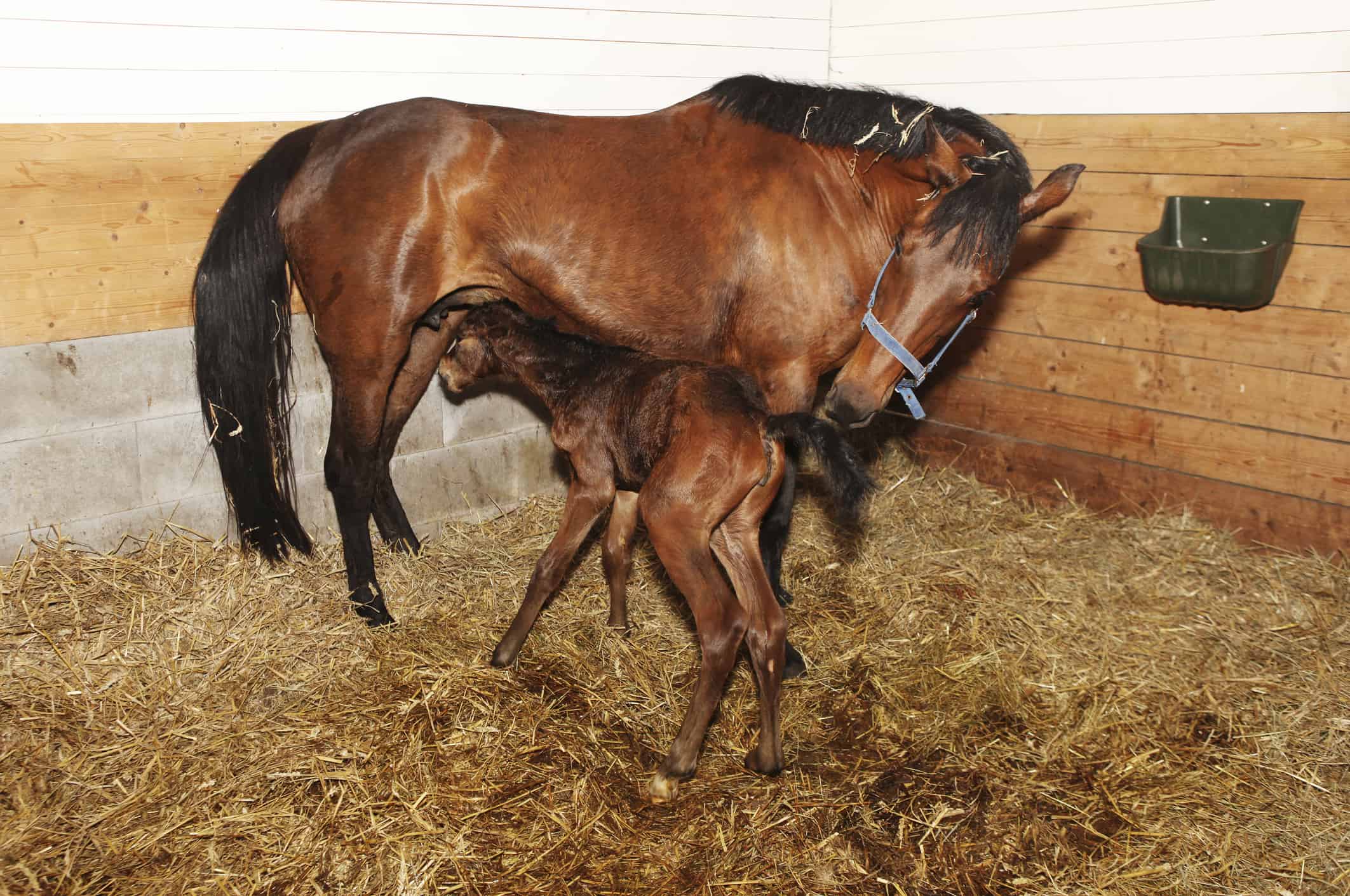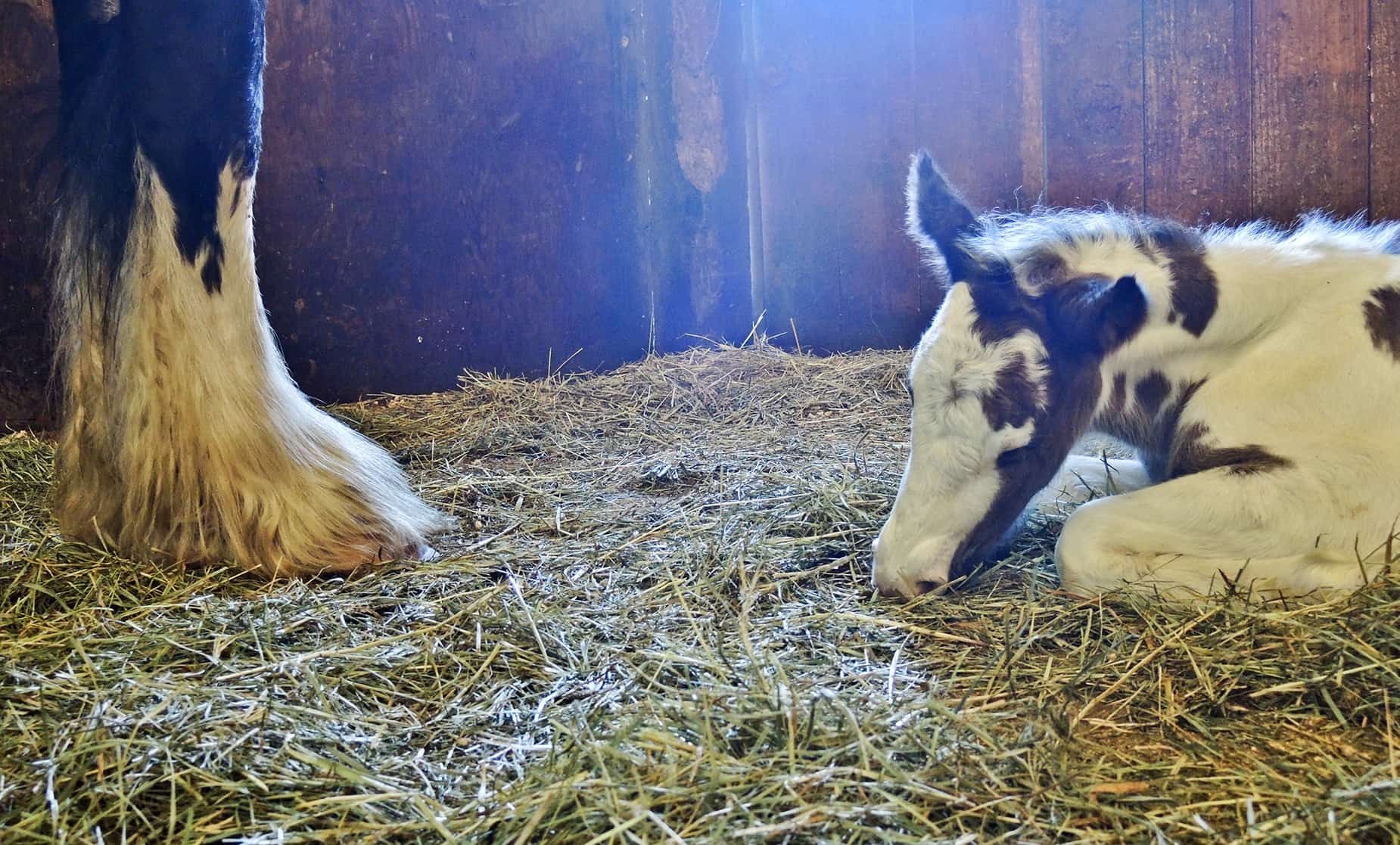Save That Foal: How to Keep Newborn Foals Healthy

Help your foal survive his first few days in a great big pathogen-filled world
That tiny newborn foal, still wet and a little lost and confused in his new world, is the culmination of more than a year of planning, vet visits, and careful prenatal care. But an uneventful arrival isn’t necessarily a guarantee you’re in the clear. The first few days of a foal’s life are critical. He has set milestones to reach with short deadlines, and missing them could spell trouble that can mean serious, sometimes lifelong consequences and even death.
To optimize your newborn’s health, make sure you know what’s normal and what’s not. In this article we’ve provided the “green lights” and “red flags” of neonatal health. You’ll also find guidelines about how to handle the warning signs and what to expect if your foal’s health starts going downhill.
Standing and Moving
Green Light Your new baby is a quick learner when it comes to locomotion. Within five minutes he should already be lying sternal (upright, with his chest against the ground), says Amanda House, DVM, Dipl. ACVIM, clinical professor of large animal clinical sciences at the University of Florida’s College of Veterinary Medicine, in Gainesville.
Within one or two hours foals should be standing on their feet, she says. And by six to seven hours babies might already be galloping. “They’re really ambulatory quite quickly,” she says. While they might be slightly wobbly and unbalanced, they’re essentially sound.
Foals are extremely active little horses that need a lot of rest. “It’s often surprising to owners, but foals can spend about a third of their early lives just lying down and sleeping,” House says. “When they’re awake, though, they’re active and moving comfortably around the mare.”
Red Flag Babies that don’t hit their locomotion milestones by these deadlines or spend most of their time “lying out flat” warrant rapid veterinary evaluation, says Sarah Louise Gough, DVM, of Rainbow Equine Hospital, in Malton, U.K. Any signs of lameness or joint swelling also raise concern. “Bacterial infections can get localized into the joints and bones,” she says.
Nursing
Green Light Foals should be nursing very soon after standing—within two to three hours after birth, says House. After that first suckling they should nurse four to six times per hour. Their tongues need to create a “visible seal on the teat” with effective swallowing, adds Gough. “Gently put your hand under their throat to feel if they’re swallowing,” she says.
Red Flag Signs a foal isn’t nursing correctly—aside from simply avoiding the udder altogether—include a full and tight udder “that hasn’t been properly stripped out,” says Gough. “Milk coming from the nostrils while nursing, or udder-seeking behavior that doesn’t include actually latching onto the teat, are also bad signs.”
Urine and Stool Output
Green Light Meconium is the thick, tarry, pelletlike stool that’s the first material to exit the foal’s digestive system. Breeders should see the meconium pass within four to six hours after the first suckling, says House. Once the neonate eliminates the meconium, he should create three to five piles of pasty—“toothpaste consistency,” she says—stool per day.
As for renal (kidney) function, foals should urinate for the first time within the first nine to 10 hours, she says. Monitor foals for straining to urinate, and contact your veterinarian if you notice this.
Red Flag An absence of stool is cause for alarm, says House, as is any form of diarrhea. Diarrhea “can look more like a puddle consistency,” she says. If you don’t see the stool itself, you might notice fecal stains on the foal’s hind legs. “Some foals get diarrhea at around 10 days old, due to the mare’s first heat after foaling, but anytime before that I don’t expect to see any diarrhea at all,” she explains. “Diarrhea in the first few days of life is one of the primary things we’re concerned about. If there’s any blood or if it’s more fluid than toothpaste (in its consistency), get an evaluation immediately.”

General Appearance
Green Light Healthy foals sleep a lot and frequently. But when they’re awake they’re very active and should react quickly to stimuli, says Gough. “In the wild foals will keep up with the herd within a few hours of birth, so they should be quite lively,” she says.
Their gums can give a good indication of general health, says House. They should be pink, moist, and slippery. Handlers can check capillary refill time by pressing gently on the gums with the pad of a thumb for about a second until the spot turns white, then releasing. “The gums should get their pink color back in less than two seconds,” she says.
Red Flag Foals that look “a little dull,”aren’t “up bouncing around,” or don’t look like they’d be able to keep up with a herd on the run could have something wrong, Gough says.
Dry or whitish-gray gums are another bad sign, adds House. Capillary refill of two seconds or more or having sunken eyes suggests dehydration, for which the foal needs immediate intervention.
Baby horses can also colic, so be on the lookout for rolling, lying on the back, or tucking up the legs while lying on the side, says Gough. “Any of these signs require prompt veterinary attention,” she says.
Vital Signs
Green Light Foals’ vital sign measurements aren’t the same as adult horses’, so it’s important to know what’s normal, says House.
Temperature should run anywhere from 99 to 102 degrees Fahrenheit, she says. Pulse can range from 80 to 120 beats per minute. And respiratory rates fall between 20 and 40 breaths per minute.
Red Flag Sick foals’ body temperatures can be too high or too low, House says.
“Any body temperature outside that normal range should trigger a vet visit,” she says. The same is true for heart rate.
As for respiratory rates, anything out- side the normal range should also raise serious concern, says House. In particu- lar, high respiratory rates or significant breathing efforts could indicate pneumo- nia or other serious respiratory diseases.

When Things Go Wrong
If you notice any of these red flags, don’t wait. Our sources say to contact your veterinarian immediately. Even if the foal appeared normal and healthy initially, things can change within a few hours.
When young foals’ health parameters start going downhill, time is of the essence.
Over the phone, give your veterinarian the specific red flags you’ve seen. After that, your role is primarily to be patient, our sources say.
“In the absence of knowing what’s going on, just watch the foal,” says House.
You can take the foal’s temperature every hour or two, says Gough. And you can try to ensure he’s dry and comfort- able. “Keep the foal warm in cold weather or cool in hot weather and essentially protected from inclement weather,” she says. “If the foal is recumbent (unable to rise) and the veterinarian will take a while to arrive, then turn the foal over every two hours and make sure he’s dry, particularly drying up any urine he might have passed, to reduce the risk of bed sores and lung injury.”
Take care how you turn your foal, though, cautions House. “Don’t pick them up under the abdomen but, rather, put your arms around the front limbs and behind the hind limbs to prevent putting pressure on the internal organs,” she says.
You can encourage the foal to nurse by bringing him close to the mare’s udder, but don’t force him to drink, our sources say.
“If a foal isn’t nursing, he probably doesn’t have normal reflexes in his pharynx (throat) to allow proper swallowing, so these foals are at increased risk of aspirating milk (into the lungs), which can lead to fatal pneumonia,” adds Gough. “So don’t force, and do not try to bottle-feed a foal that isn’t nursing.”
Record-Keeping
Veterinarians can better diagnose and treat foals if they have accurate background information to aid their investigations, our sources say. That’s where dutiful record-keeping becomes critical.
“It would be great if handlers could observe behavior and even take temperature readings on foals twice a day in the early days,” House says.
Take notes on the foal’s history since birth, and have those notes available to show a veterinarian, adds Gough. “Make sure you’re there to witness the actual birth and mark down any complications you see,” she says. Keep a timeline of all the foal’s milestones—standing, nursing, passing meconium, urinating.
But don’t wait for the foal’s arrival to begin taking notes, Gough says. Keep good records of the mare’s gestation period, as well. “Write down insemination dates and gestation lengths—including past gestation lengths for that particular mare, as individual mares tend to be fairly consistent, because this can help us determine if the foal is of normal gestational age at birth,” she says.
For example, a mare that usually foals at 360 days could suddenly foal at 335 days (which is just under the average of 342 days). “The foal might seem to be born at a normal gestational age according to global standards, but he’s actually quite premature,” says Gough. If the mare has had previous difficult foalings, indicate that in her records, as well.
Finally, check the placenta for obvious defects and save it for your veterinarian to examine. “Placental thickness during gestation can help alert us to potential placental problems that can make the postpartum period higher-risk,” Gough says. After foaling, also write down a description of the fetal membranes—time of passing, signs of thickening or abnormalities, and whether they were intact.
Failure of Passive Transfer
Unlike many other mammals, horses are born without antibodies. In other species antibodies transfer from the mother through the placenta to the fetus. Equids, however, must receive all their early antibodies through colostrum—the first milk. Foals that don’t get antibody-rich colostrum suffer from failure of passive transfer and are at high risk of developing infections from environmental pathogens (disease-causing organisms), says Amanda House, DVM, Dipl. ACVIM, of the University of Florida.
“Passive transfer of immunity alone is not a disease,” she says. “However, it predisposes neonates to infection if not immediately identified and corrected (through plasma administration). Serum immunoglobulins (antibodies) in foals can be tested between 12 and 24 hours of age (ideally within eight to 14 hours) and should be 800 mg/dl or higher.
Less than 200 mg/dl indicates complete failure of passive immunity, and 200-800 mg/dl is considered partial failure. Historically, foals require a minimum of 2 liters of colostrum in the first eight hours of life.”
—Christa Lesté-Lasserre, MA
What’s Wrong?
All neonatal foals should undergo an on-farm veterinary examination soon after birth. This will include a physical exam, checking the foal’s vital signs and behavior, and palpating him. The veterinarian will draw blood to evaluate white blood cell count for signs of infection and run a chemistry profile to verify whether any values are out of range, pointing to issues affecting specific organs, says Gough.
A critical assay your veterinarian will run is an IgG test to check your foal’s immunity level. Because foals are born with no resistance to disease, it’s crucial they receive antibodies from their dams’ colostrum, or first milk, says House. Foals that don’t consume enough colostrum or have ingested colostrum that has low antibody levels suffer from failure of passive transfer, placing them at a very high risk of disease because they lack immunity (see sidebar).
Your veterinarian should also screen for a variety of issues that can escalate quickly, including pneumonia from inhaling Rhodococcus equi bacteria, lung infections from accidentally aspirating milk, sepsis (a generalized bacterial infection), dummy foal syndrome (in which they “don’t seem to adapt to life outside the uterus,” says Gough, with slowed physical and mental activity), scrotal and umbilical hernias, bite abnormalities, ocular problems, fractured ribs, lax or contracted tendons, crooked legs, congenital defects, and other problems.
If a foal has clinical signs suggesting lung conditions or joint infections, chest and joint radiographs (X rays) can provide useful insight for diagnosis, House says. Joint taps and blood cultures can help identify the agents causing issues so the veterinarian can better fine-tune treatment.
Serum amyloid A (SAA, a protein produced in response to inflammatory insults) readings on blood can differentiate bacterial infections from other kinds of illnesses, says Rose Nolen-Walston, DVM, Dipl. ACVIM, associate professor of medicine at the University of Pennsylvania’s New Bolton Center School of Veterinary Medicine, in Kennett Square.
“Recent data suggest that SAA can be used in foals even at young ages as an indicator of infectious or inflammatory processes, especially given that its quicker rise allows abnormalities to be identified in the first few days of life,” she says. One exception, though, is R. equi. “Current data suggest SAA is not a good screen- ing tool for Rhodococcus equi,” Nolen-Walston says. “Nobody really knows why.”
Another important biomarker to check is fibrinogen, adds Gough, which is a soluble protein clotting factor in the blood, elevated levels of which indicate infection or inflammation. “Fibrinogen levels suggest more chronic inflammation,” she says. “High fibrinogen in a newborn suggests there has been inflammation in utero, which is important to know.”
Advancing technology and research are opening doors for even better understanding of foal diseases, says Gough. “Survival is definitely improving in recent years,” she says. “We’re getting better at picking up early signs but, also, technology is advancing. We understand disease processes more, and we have better information about bacteria so we can choose the most effective antibiotics. Equine hospitals also have more advanced therapy equipment for an improved overall nursing component. This allows us to determine exactly what each patient needs and tailor the care to enhance outcomes.”
Take-Home Message
While most foals are born healthy, some enter the world already ill, and others develop disease within hours or days. Without rapid treatment, a sick foal’s condition can go downhill fast. To give your baby the best chance for a healthy start to life, understand the red flags—and the green lights—so you can be prepared to make that critical call to your vet to ensure your foal has a fighting chance to be the active little equid he’s meant to be.

Written by:
Christa Lesté-Lasserre, MA
Related Articles
Stay on top of the most recent Horse Health news with



















